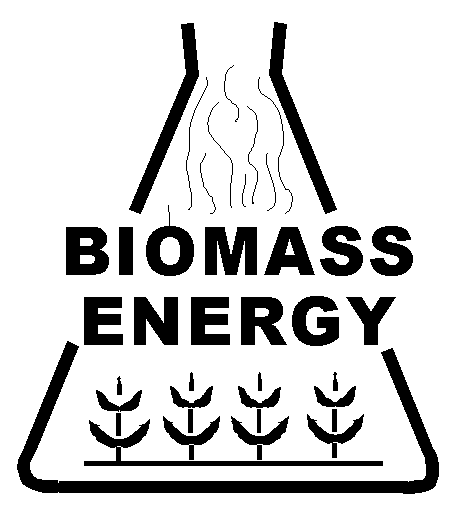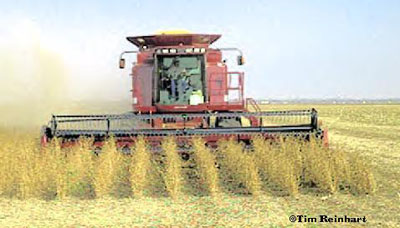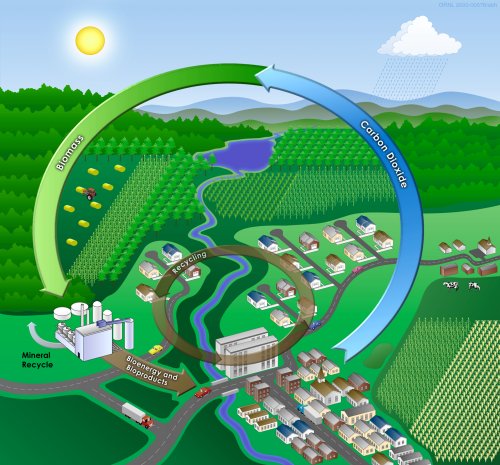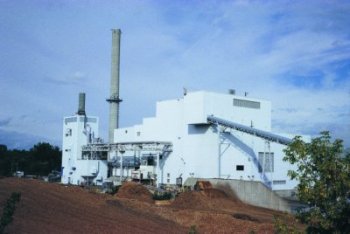 ~~~~~~~
~~~~~~~ ~~~~~~~
~~~~~~~
What is Biomass?
Simply defined, biomass is all plant material, or vegetation, either raw or processed, wild or cultivated. Examples of this energy source include:
 · fast growing trees and grasses
· fast growing trees and grasses
· agricultural residues like used
vegetable oils, wheat straw, or corn 
 · wood waste like paper trash, yard clippings, sawdust, or wood
chips
· wood waste like paper trash, yard clippings, sawdust, or wood
chips
· methane that is captured from
landfills, livestock, and municipal waste water treatment  (MOO!!)
(MOO!!)
Essentially, biomass is stored solar energy that man can convert to electricity, fuel, and heat. Through photosynthesis the energy from the sun is stored in the chemical bonds of the plant material. Typically biomass energy comes from three sources: agricultural crop residues, municipal and industrial waste, and energy plantations. In addition, crops such as corn, sugar beets, grains, and kelp can be grown specifically for energy generation. Crops that make good energy resources have a high yield of dry material and use minimal land; the crop should also generate more energy than its production consumes. Numerous processes such as cogeneration, gasification, and fermentation, can tap into this energy source to produce energy available for human consumption.
 History of
Biomass
History of
Biomass 
Prior to the industrial revolution, biomass satisfied nearly all of man's energy demands. Up until the 1860s, the United States used biomass, in the form of wood, for nearly 91% of all energy consumption. In 1992 biomass generated $1.8 billion in personal and corporate income and employed 66,000 workers. Although presently the majority of humankind's energy requirements are fulfilled by fossil fuel combustion, 14% of the world still utilizes biomass.
How Much Biomass is There?
Without a major impact on food prices, the United States has enough land and agricultural networks to sustainably replace half of the nation's gasoline use or all nuclear energy. The thousands of tons of manure, piles of sawdust, and mounds of agricultural waste all have the potential to generate energy.
Currently, the world population uses only about 7% of the annual production of biomass. We are only partially utilizing nature's abundant and renewable resource.
How is
Biomass Converted? 
The least costly, most common, and simplest method is direct combustion or burning of the biomass which produces energy for activities such as heating or cooking. Currently, numerous technologies exist that convert organic material to commercial energy. The list below represents only a sample of the many ways in which biomass can be used:
· Alcohol Fermentation
With alcohol fermentation starches are converted to sugar and then to fuel alcohol. This alcohol is then distilled and separated. With yeast, materials such as wheat, barley, potatoes, and sawdust can be converted to alcohol. Currently, ethanol is the product from fermentation that is used in internal combustion engines as alternative fuel.
· Landfill Gas
Decomposing organic waste generates gas
as it is anaerobically digested. Approximately 50 percent of this is
methane-a major factor of natural gas. People have developed ways to
harness this methane and use it for energy. An example of this is
Foster Farm in Middlebury, Vermont that uses cow manure to power the
entire dairy farm!  (Manure holding
pit)
(Manure holding
pit)
· Gasification
The newest method for electricity generation is known as gasification. This method captures 65-70% of the energy present in solid fuels by first converting it to combustible gases. These gases are then burned, like we currently burn natural gas, and create energy. The technologies for this synfuel (synthetic fuel) are still new and therefore not quite ready for commercial production.
There are countless benefits to biomass use economically, environmentally, and nationally. They include:
Economic Benefits $$$$$
· Rural economic development and stability: we spend $50 billion each year importing oil, biomass could replace half of this and direct a minimum of $25 billion to the U.S. economy not to foreign oil markets
· The United States Department of Agriculture estimates that 17,000 jobs are generated for every million gallons of ethanol
· Defending our access to foreign oil supplies is extremely costly. Diversification of fuel sources would cut down on military spending and shift the focus to domestic welfare.
· The Electric Power Research Institute estimates that producing 5 quads of energy from 50 million acres of land will increase annual farm income by $12 billion in Britain. The U.S. consumes 90 quads annually, that's 18 times Britain's estimates!
Environmental
Benefits

· Preservation of agricultural land that otherwise would be sold for residential development or industrial use = wide open spaces!!
· Sustainable agricultural techniques for these crops can restore and ensure soil stability and health along with minimizing chemical residues and habitat destruction.
· Methane is 20 times more potent than CO2. Capturing methane from producers such as cows or rice fields and applying it for fuel will significantly reduce this greenhouse gas.
· Increased carbon sequestering from the crops grown for biomass.
· Use of waste from agricultural and timber industries. An estimated 350 million tons of waste that goes to landfills could be used for energy production.
· No net increase in atmospheric carbon dioxide.
The Future of Biomass
Many barriers to entry, such as small
Federal investment in biomass research, currently relegate biomass
plants to small niche markets and individual's efforts. New
technologies are being developed and small scale projects are
economically efficient and environmentally sustainable. The United
States has the land, the economic resources, and the agricultural
infrastructure to shift a large portion of our energy requirements to
the biomass sector.  Joseph C. McNeil Station:
Burlington, VT
Joseph C. McNeil Station:
Burlington, VT
Despite the lack of Federal support, biomass generation for electricity is increasing in popularity. The picture above is of the Joseph C. McNeil Generating Station in Burlington, Vermont. This station generates energy from all wood resources.
Resources
International Council for Local Environmental Initiatives
E-Grass - An example of a renewable energy resource
Biomass Energy Research Association
The U.S. Department of Energy's Alternative Fuel News
Energy Efficient and Renewable Energy Network (EREN)
Office of Fuels Development Biofuels Program
Center For Renewable Energy and Sustainable Technologies - information about Biomass
United Bioenergy Commercialization Association
National Renewable Energy Laboratory - information on Biomass
BOOKS
Brower, Michael. Cool Energy: The Renewable Solution to Global Warming. Union of Concerned Scientists, 1990.
Howes, Ruth and Fainberg, Anthony. The Energy Sourcebook: A Guide to Technology, Resources, and Policy. American Institute of Physics, 1991.